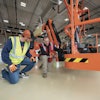Trying something new is always a little scary. Trying it when it costs thousands of dollars and has the potential to substantially impact your bottom line is downright frightening. We’ve all seen what can happen. A company invests heavily in the latest and greatest new thing only to find itself overleveraged with the wolves howling at the door. Not a pretty picture.
Yet, there is also a risk in being prudent to the point that your company loses its competitive edge. Failure to think long term, and occasionally outside of the box, can result in loss of business to others willing to invest in new equipment, systems or processes that can cut project completion times/costs and expand revenue opportunities.
Many construction companies are finding themselves at a crossroads. Business has increased but continues to be inconsistent, making future backlogs uncertain. Losses suffered during the Great Recession retain sufficient sting to cause hesitation about re-investing in the business. And the U.S. economy’s yo-yo path to recovery is not boosting anyone’s comfort level about major capital expenditures.
Yet, conditions are such that investment in new units to replace aged equipment, technology to enhance production efficiency, added iron to compensate for a shortage of labor — whatever the individual case may be — can’t be put off much longer. Ongoing growth in construction activity is projected through at least 2016, barring unforeseen economic shocks. The time has come to start making some tough choices about the future of your business.
This doesn’t mean jumping in headlong. Rather, the old adage “look before you leap” applies now more than ever. Whether it’s the type of equipment/technology you intend to acquire or how you plan to acquire it, investigate all of the options to ensure you’re making educated choices.
Publications such as Equipment Today and websites like ForConstructionPros.com can help you identify and/or narrow down available products or services, but it’s up to you to perform due diligence to ensure they make sense for your business. This involves talking to manufacturers, dealers and other end users to find out what may work best for your particular circumstances, then taking units out on test to ensure they perform as promised.
Next, determine the optimal financing strategy for your operation. Assess the options offered through your bank or dealership, and shop and compare rates and terms to secure the deal that makes sense for your situation. While bank lending standards have loosened somewhat, find out in advance if you qualify for the required funds or will have to seek alternatives elsewhere.
Be sure to factor in rental as a means of acquiring necessary iron. With roughly 50% of all new equipment going into rental fleets, availability of late-model machines is good and the variety of equipment types on rental lots is expanding to meet a wider range of applications. There has never been a better time to take advantage of rental to cover short-term needs; more efficiently match equipment to the job; or reduce manpower requirements. Rental can also be used to more accurately estimate equipment costs into your bids.
As a conservative spender, I get the need for caution when it comes to making major investments. I rarely throw it entirely to the wind, but even I recognize there’s a point where you have to let go of the purse strings in order to progress. The key is to research all of the variables to ensure you get the best value per-dollar spent. Doing your homework before you spend can help you sleep better at night — and help keep those noisy canines away from your door.


















